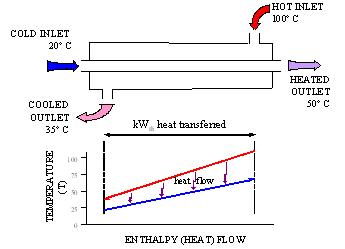Harry R Cripps
Principles of heat exchangers
Simplified heat exchanger concepts
Heat exchangers work because heat naturally flows from higher temperature to lower temperatures. Therefore if a hot fluid and a cold fluid are separated by a heat conducting surface heat can be transferred from the hot fluid to the cold fluid.

Figure 1 Simplified Heat Exchanger
The rate of heat flow at any point (kW/m2 of transfer surface) depends on:
- Heat transfer coefficient (U), itself a function of the properties of the fluids involved, fluid velocity, materials of construction, geometry and cleanliness of the exchanger
- Temperature difference between hot and cold streams
- Heat transfer surface area (A)
- Heat transfer coefficient
- Average temperature difference between the streams, strictly the log mean (DTLM)
- But the larger the area the greater the cost of the exchanger
Return to main heat recovery article